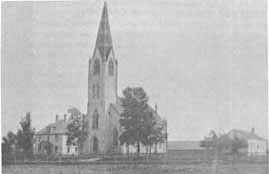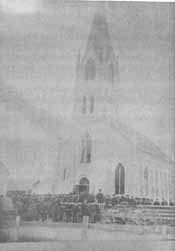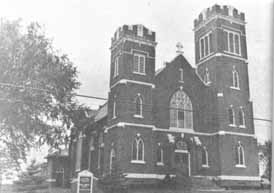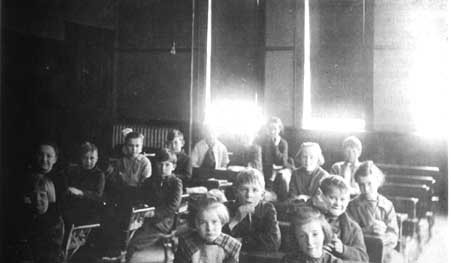


|
St. John's Lutheran, Newtonburg St. John's Lutheran, Mantitowoc St. John's Lutheran, Two Rivers First German Lutheran Society, Manitowoc Norwegian Lutheran Church, Manitowoc ST. JOHN'S EVANGELICAL LUTHERAN CHURCH, NEWTONBURGInformation from: "A History of Manitowoc County", Ralph G. Plumb; "History of Manitowoc County", Dr. Louis Falge; "The Blum Family History", H.E. BlumSt. John's Evangelical Lutheran church was founded in the year 1851 A.D. It was the first Lutheran congregation in Manitowoc County. St. John's was founded one year after the establishment of Newton Township. The church is situated about five miles southwest of the city of Manitowoc.
The first pastor of the congregation was Pastor Carl F. Goldhammer. Pastor Goldhammer was born in Urspergk Saxony, on Feb. 9, 1821. He received his Theological training in Germany. He was also an immigrant. His first work was in Dodge County, administering to the spiritual needs of the German immigrants. In 1855, Paster Goldhammer left the congregation to accept a call extended by St. John's of Manitowoc. The menfolk put out calls for a new pastor. Pastor Streissguth served the congregation from 1856-1857. He would stop on his travels between Algoma and Milwaukee. Rev. Goldhammer did not limited his services. At the same time, he held services in Manitowoc.(See St. John's, Manitowoc). On April 9, 1855, Rev. Goldhammer accepted the call to the congregation in Manitowoc. In 1857, Reverend P.H. Sprengeling accepted their call to serve them. During his serve, the congregation constructed a new frame church. The previous structure had been of logs. Time of worship was wet at 9:00 a.m. on a Sunday morning from Easter to September. At the time many families had no horse or wagon for travel. The trip to church was made on foot. Due to potentially inclement weather during the colder months, time of worship from September to Easter was 10:00 a.m. At this time the members agreed to pay the pastor at least two dollars per year for his salary. In 1863, the members of the congregation agreed to pay the Pastor $1.50 per family per year in cash and supply him with the necessities of life. In September 1901, the Newton church celebrated it's golden anniversary. Among the pastors have been Revs. C. Wagner, E. Strube, A, Pieper and Christian Sieker. In 1903, a school was established. A quote from the booklet on the One Hundreth Anniversary of the Congregation, "With an iron will and confidence in their God these hardy pioneers cut a livelihood out of the Wisconsin forest and gave us the fertile farms which play such a vital part in maintaining St. John's Congregation in this community today. We can rightfully say that their confidence and faith in God played a part in establishing their new home in Wisconsin's Virgin Forest. Surely these pioneers worked, clearing land, tilling the soil, sewing and reaping, or they starved to death. IN those days there were no government agencies to sustain the farmer and help him over a bad year, he had to make his way the best he could and he knew how to do it. This sturdy pioneer did not only think of his daily bread in terms of work, earning power, dollars and cents, he thought of his daily bread in terms of blessings from God. He understood the truth and unless the Lord bless the labor of his hands, he works without lasting success". End of quote. In 2000, under God's guidance and protection the congregation has grown to a family of over 600 members. The school is currently a PreK-8th Grade Lutheran Elementary School. There are currently 100 students 4 full time teachers and 3 part time teachers. 
  St. John's 1968
Rev. Goldhammer was not a man to limit his usefulness and as early as 1851 he came to Manitowoc every second week to hold services with a few families. For years these gatherings took place in the old district school at the corner of South Seventh and Washington streets. Finally on April 9, 1855 St. John's congregation was organized in the village with thirty families in church connection and it was decided to call Rev. Goldhammer to the parish. He accepted and a church, parsonage and school were completed the following year, the latter being enlarged in 1859 to meet the growing demands. The church was a frame structure 35 by 50 feet in dimensions, which was capable of seating about four hundred people. In 1858 Rev. Goldhammer left for Burlington, Wis. and Rev. Philip Koehler accepted the work and responsibility for the next nine years. In 1861 the congregation had a membership of ninety-one families; in 1865 the report shows 184 families and 193 children in school attendance. By act of the legislature March 23, 1866 the congregation was incorporated and in the same year a new school was erected, which continued to do duty for twenty-five years until it was taken away to make room for the present structure. Rev. Koehler left in 1867 and was succeeded b Rev. M.. Quehl. It was during his pastorate that the old church proving utterly inadequate, it was decided to build a new brick structure. The building was completed in 1873 at a cost of $16,000 and is one of the most commodious in the city. By this time Rev. K. Huebner had taken up pastoral work in the city but after two years service he gave way, in 1874, to Rev. G. Thiele, later of Milwaukee. Rev. F. Pieper assumed charge in 1876, followed by Rev. R. Pieper in 1878. Two years later the Synod of Minnesota and Wisconsin met at St. John’s and the church was again chosen as the gathering place in 1894. In February 1891 Rev. Karl Machmueller, the present pastor, assumed charge and has assisted materially in the development of church life. The congregation numbers 435 families and there are 250 children in attendance at the school. A thriving ladies' society is maintained in connection with the church.(1904)
As early as 1861 occasional Lutheran services were held in the village of Two Rivers but it was not until 1863 that St.John’s Congregation was organized by Rev. H. Barthels, a. missionary pastor of the churcb. In the same year "the little brown church" built and owned by the Episcopals was purchased from Bishop Kemper and was used as a place of worship by the new congregation. Rev. Barthels remained until the latter part of 1865 and was succeeded by Rev. Braun and under his pastorate a parsonage was built. In October 1869 Rev. Braun was succeeded by Rev. Zuberbier, who died in the midst of his activities in 1872, whereupon Rev. C. Jaeger assumed pastoral duties for six years, he now being a resident of Racine. His successor was Rev. P. Lucas, who passed away at Two Rivers July 28 1881, Rev. J. P. Koehler then taking up the work. He remained seven years, at the end of which time he resigned to accept a position as professor in the Northwestern Theological Seminary in Watertown. It was under his guidance that the congregation decided to build a new church ediface. The building operations, however, were carried on by his successor, Rev. A. F. Siegler, the dedication takeing place in 1899. In September 1892, the present pastor, Rev. C. A. F. Doehler,, assumed charge of the church and hunder his leadership it has prospered, numbering now about nine hundered communicants. The school, started at the same time as the church, was for ten years under the care of the pastors but from that time on teachers were hired and the institution now numbers 160 scholars. Two frame structures are utilized for school purpose, one of them being the old church.  Students at St. John's School, Two Rivers c1917-1921 Students Unidentified The last German confirmation class was confirmed on May 6, 1921 ROSE ANNA MARIE JAECKEL is the girl in the front row center with the big bow (the girl second from right side of photo) her married name was ROSE ANNA MARIE SWANSON. info. supplied by her daughter.

FIRST GERMAN LUTHERAN SOCIETY- MANITOWOCThis Society was organized in 1853. In 1855, a neat comfortable church, 30x50 feet, capable of seating about 400, was erected. The church has flourished amazingly, and now has a large membership. Rev. 0.F. Ebert is the pastor. Beside the church, the society owns a brick parsonage 30x30 feet, two stories, with a wing 15x20; a school house 25x40, two stories, and the whole of the block fronting on Eight street, between Hancock and Marshall streets; a valuable piece of property. About 200 scholars are in regular attendance at the school. 
NORWEGIAN LUTHERAN CHURCH-MANITOWOCSociety organized in 1855. The first stated minister was Rev. J.A. Otteson. The congregation for many years, worshipped in the First District School House, but about two years ago they commenced the erection of a church on the corner of Eighth and State streets. This building, as near as we can learn, is about 50x80 feet, and owing to its position, is an ornament to the place. It cost about $5,000. Services were first held in it last Christmas day. Rev. L.M. Biorn is the pastor.
From "A History of Manitowoc County" A Norwegian Methodist church was organized in Manitowoc in 1869, Rev. C. Jensen being chosen the first pastor. The charge included a church at Sheboygan also and both were placed under the Northwest Norwegian Conference. A small frame church was erected on North Sixth street and the membership was at first nineteen in number, gradually increasing as the years went by. Rev. Jensen was succeeded by Rev. B. Johansen in 1872, who retained the charge for two years, his successor being Rev. Charles Omann, who remained for a like period. In 1876 Rev. 0. Wiersen was assigned to Manitowoc and Sheboygan, and was succeeded a year later by Rev. Gustafsen, who in turn gave way to Rev. 0.L. Hansen after a year’s ministry. Since 1880, however, there have been no regularly appointed ministers, occasional visits being made by itinerant evangelists. Reverend Peterson of another denomination of faith occupied the pulpit for some time in 1900.
|